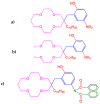Fluorescent and Phosphorescent Nitrogen-Containing Heterocycles and Crown Ethers: Biological and Pharmaceutical Applications
- PMID: 36235167
- PMCID: PMC9573242
- DOI: 10.3390/molecules27196631
Fluorescent and Phosphorescent Nitrogen-Containing Heterocycles and Crown Ethers: Biological and Pharmaceutical Applications
Abstract
Fluorescent molecules absorb photons of specific wavelengths and emit a longer wavelength photon within nanoseconds. Recently, fluorescent materials have been widely used in the life and material sciences. Fluorescently labelled heterocyclic compounds are useful in bioanalytical applications, including in vivo imaging, high throughput screening, diagnostics, and light-emitting diodes. These compounds have various therapeutic properties, including antifungal, antitumor, antimalarial, anti-inflammatory, and analgesic activities. Different neutral fluorescent markers containing nitrogen heterocycles (quinolones, azafluoranthenes, pyrazoloquinolines, etc.) have several electrochemical, biological, and nonlinear optic applications. Photodynamic therapy (PDT), which destroys tumors and keeps normal tissues safe, works in the presence of molecular oxygen with light and a photosensitizing drugs (dye) to obtain a therapeutic effect. These compounds can potentially be effective templates for producing devices used in biological research. Blending crown compounds with fluorescent residues to create sensors has been frequently investigated. Florescent heterocyclic compounds (crown ether) increase metal solubility in non-aqueous fluids, broadening the application window. Fluorescent supramolecular polymers have widespread use in fluorescent materials, fluorescence probing, data storage, bio-imaging, drug administration, reproduction, biocatalysis, and cancer treatment. The employment of fluorophores, including organic chromophores and crown ethers, which have high selectivity, sensitivity, and stability constants, opens up new avenues for research. Fluorescent organic compounds are gaining importance in the biological world daily because of their diverse functionality with remarkable structural features and positive properties in the fields of medicine, photochemistry, and spectroscopy.
Keywords: anti-microbial; antifungal; antitumor; fluorescence; heterocyclic compounds.
Conflict of interest statement
The authors declare no conflict of interest.
Figures














References
-
- Schulman S., Sharma A. Introduction to fluorescence spectroscopy. Microchem. J. 2000;65:353. doi: 10.1016/s0026-265x(00)00048-5. - DOI
-
- McGown L.B., Nithipahkom K. Molecular fluorescence and phosphorescence. Appl. Spectrosc. Rev. 2000;35:353–393. doi: 10.1081/ASR-100101229. - DOI
-
- Derkowska-Zielinska B., Skowronski L., Biitseva A., Grabowski A., Naparty M.K., Smokal V., Kysil A., Krupka O. Optical characterization of heterocyclic azo dyes containing polymers thin films. Appl. Surf. Sci. 2017;421:361–366. doi: 10.1016/j.apsusc.2016.12.080. - DOI
-
- Maliyappa M.R., Keshavayya J., Mallikarjuna N.M., Krishna P.M., Shivakumara N., Sandeep T., Sailaja K., Nazrulla M.A. Synthesis, characterization, pharmacological and computational studies of 4, 5, 6, 7-tetrahydro-1, 3-benzothiazole incorporated azo dyes. J. Mol. Struct. 2018;1179:630–641. doi: 10.1016/j.molstruc.2018.11.041. - DOI
Publication types
MeSH terms
Substances
LinkOut - more resources
Full Text Sources

